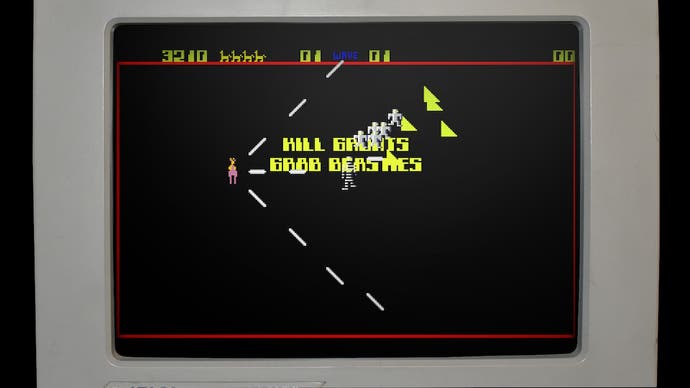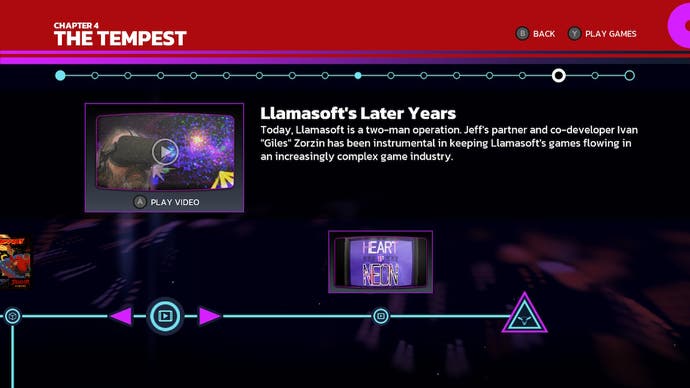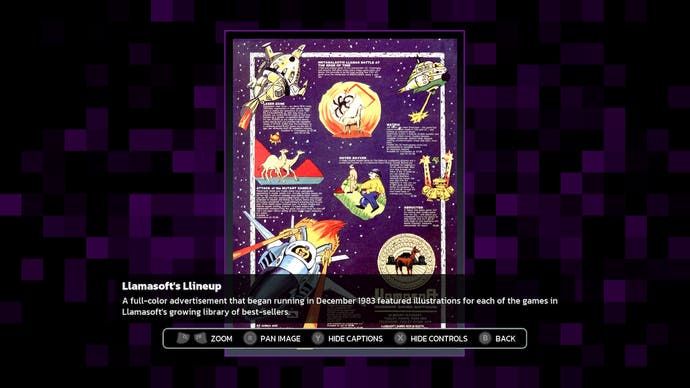The black screen has a single white dot in the center. The expectation is that something like Pong awaits us: something simple, direct, immediate and, as far as games go, old.
But then the point moves and, in its wake, eruptions of light occur. The blocks of color fan out, going from pink to purple to cyan. Light creates shapes, but what are those shapes? Starbursts, nebulae, volcanic eruptions. The screen seems to mirror the action, to duplicate it, so we have many crabs with two claws raised towards the sky, many mermaids with two fins, many Rorschach blots. Maybe that's it. You look at these dancing lights, these waves of color, all caused by a single white dot, and you see what you want to see.
This is Psychedelia, from 1984. It was the first of designer Jeff Minter's light synthesizers, inspired by the colors and shapes he saw when lying in his room, listening to “the Floyd.” I always knew that Minter made light synths, because his later games, like Space Giraffe, are often set within them. But coming across Psychedelia halfway through Llamasoft: The Jeff Minter Story, I was able to appreciate them in a new way.
 Llamasoft: The Jeff Minter Story | Launch Trailer
Llamasoft: The Jeff Minter Story | Launch TrailerThat change, from the arcade games you had created before this, to something like Psychedlia? Well, for starters, “change” is the wrong word. Neither will Leap. It's like teleportation. He was doing one thing and now all of a sudden he's doing something else. The end result is impossible to describe without a certain degree of mutual exclusivity. Psychedelia seems unprecedented, but then you look back at what came before, and there's also a sudden sense of recognition. Oh, of course he did this.
Jeff Minter's story sees gaming's great digital romantic getting the Gold Master treatment. This series, still excitingly new, is Digital Eclipse's latest take on game preservation. Not only do you get the games, you also get the story behind them, which unfolds through interactive timelines that include photographs, testimonial snippets, and design sketches, along with delightful playable versions of classics in various stages of development. It's a museum or temple to gaming, and it's the ideal way to see an ancient game along with something rarely understood: the context.


And the context changes from one volume to another. The most recent Gold Master collection focused on Karateka, the precursor to Prince of Persia. Karateka's story unfolded in a way that, I now realize, provided insight into its creator. Jordan Mechner was methodical in his brilliance, in love with the details and the small, careful changes from one thing to the next. This was the story of his revolutionary game, and it was also the story of a man who saved every fragment of his work, which was his own biographer, his own archivist.
Minter is incredibly different. Here, you get a story told game after game after game, all different in some fundamental way, all full of color and energy and a very British absurdist sense of humor. Now I see that Minter's games have themes that they share, but they also advance in strange, wobbly leaps of imagination. It reminds me a little of the effect you get from reading an omnibus of Philip K. Dick stories. You see the teacher return to a topic, but changing the variables to do something different each time.


When we talk about arcade games, the rewards are immediate. This is an incredibly generous collection, and while it knocks things back on Tempest 2000 in 1994 (admittedly, it then moves on to Gridrunner Remastered, a gloriously space blaster made last year, to top it all off), all the things that associated with the heritage of Llamasoft from the 80s and 90s is here. Lots of Mutant Camels, lots of Gridrunner: that game feels like an epiphany; you can feel the sense of revelation for Minter, and a very welcome inclusion of Llamatron: 2112, which will undoubtedly be my most played game of the bunch.
I say that, but really, the stars here for me have been the Minter games I've never played before or, whisper it, never heard of. Psychedelia is something I have a hard time getting away from now. It's not the only light synth here, but it's my favorite. I have fallen into this game these past few days and refuse to get out. I might even put on The Floyd myself.

Then there is the Laser Zone. 1983. I personally like the Vic-20 version. It's a blaster where you move one turret as the aliens scatter, but this is Minter, so you move two turrets, one up and down, the other left and right. It's wild. I love it. I didn't know it and yet it could have been published yesterday. It's fresh! The same goes for the Hellgate sort of sequel where of course you now move four turrets around. 1984, that one.
All games are beautifully presented, with control guides, lots of extra information, and fast loading. But this is not just a collection of games. It really is a story, the story of a brilliant man who made brilliant games. He tells you where he comes from: Tadley, a town known for manufacturing brooms that was also home to the Atomic Weapons Research Establishment, where Minter's father worked. “In our city it was never completely silent, not even in the middle of the night,” explains Minter. “The AWRE had a constant industrial rumble in the background at all times, and you could lie in bed at night and listen to the ticking of criticality alarms monitoring the reactors.” He always knew that Minter's imagination was shaped by games like Robotron and Tempest. But how about this?
And while you don't get any of Llamasoft's recent games, the collection ends with a beautiful video about Minter and his partner and co-developer Ivan “Giles” Zorzin. It also ends with a lot of people admitting that the brilliant, scary, and wonderful thing about Llamasoft is that their games just keep getting better and better, Space Giraffe! Polybius! Akka-Arrh! All this makes me think that, if we ever get it, Llamasoft 2: The Rest of the Jeff Minter Story will be a must-see.
Digital Eclipse provided a copy of Llamasoft: The Jeff Minter Story for review.









